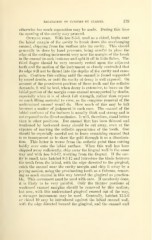Page 409 - My FlipBook
P. 409
EXCAVATION OF CAVITIES BY CLASSES. 179
otherwise too much separation may be made. During this time
the opening of the cavity may proceed.
Outline form. With hoe 8-3-6, used as a chisel, begin near
the labial margin of the cavity to break down the overhanging
enamel, chipping from the surface into the cavity. This should
generally be done by hand pressure, being careful to place the
edge of the cutting instrument very near the margin of the break
in the enamel in each instance and split it off in little flakes. The
third fmger should be very securely rested upon the adjacent
teeth and the motion of the instrument so closely controlled that
its edge will not be thrust into the depths of the cavity and cause
pain. Continue this cutting until the enamel is found supported
by sound dentin, or until the cavity of decay is well exposed. On
account of the prominent position of these teeth and the esthetic
demands, it will be best, when decay is extensive, to leave on the
labial portion of the margin some enamel unsupported by dentin,
especially when it is of about full strength, rather than expose
so much filling material to view, as the complete removal of the
undemiined enamel would do. How much of this may be left
becomes a matter of judgment in each case. The enamel of the
labial surfaces of the incisors is usually thick and strong and is
not exposed to the direct occlusion. It will, therefore, stand better
than in other positions. But enamel that has been thinned and
weakened by backward decay should be cut away, even at the
expense of marring the esthetic appearance of the tooth. One
should be especially careful not to leave remaining enamel that
is so transparent as to show the gold through it as a discolora-
tion. This latter is worse from the esthetic point than cutting
boldly over onto the labial surface. When this wall has been
chipped away sufBciently, chip away the lingual wall in the same
way and with hoe 8-3-12, working from the lingual. If the cav-
ity is small, take hatchet 8-3-12 and introduce the blade between
the teeth from the labial, with the edge directed to the gingival,
catch the enamel near the cavity margin and chip it away by a
prying motion, using the proximating tooth as a fulcrum, remov-
ing as much enamel in this way toward the gingival as practica-
ble. This movement must be used with care. If carelessly done,
it is likely to be very painful. Only the thinner portions of
weakened enamel margins should be removed by this motion;
but now, with this undermined gingival enamel out of the way,
a stronger instrument may be used. Generally, hatchet 12-5-6
or chisel 10 may be introduced against the labial enamel wall,
with the edge directed toward the gingival, and the enamel wall


